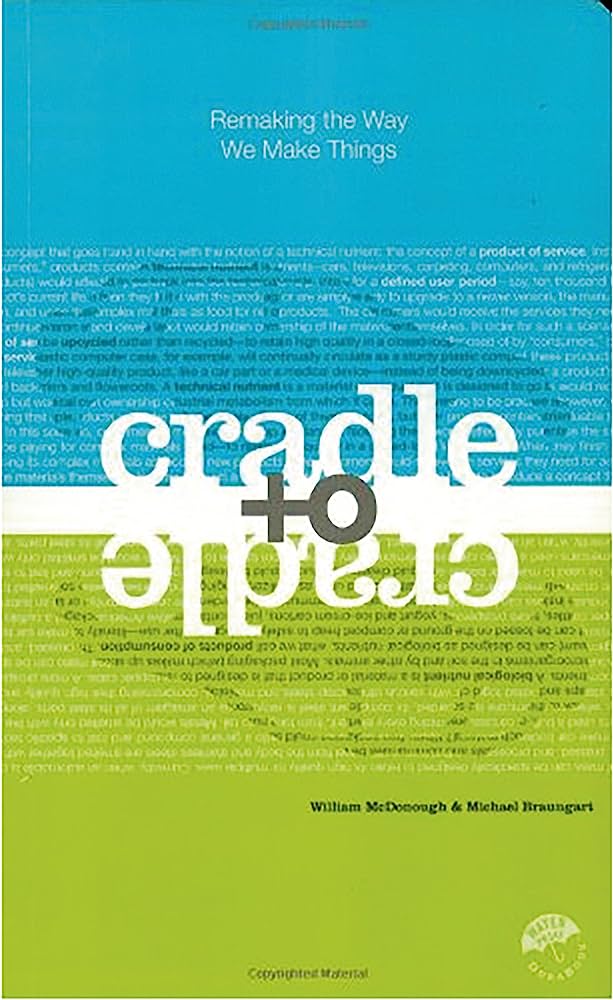“Cradle to Cradle” Book Review
“Cradle to Cradle: Remaking the Way We Make Things” by William McDonough and Michael Braungart is a groundbreaking book that challenges the traditional linear approach to manufacturing and proposes a revolutionary paradigm shift towards a regenerative and sustainable model. Drawing on their extensive experience in various fields, McDonough and Braungart present a compelling vision for the future. Their future is where all products are designed to be safe, healthy, and endlessly recyclable or biodegradable. This book review explores the key concepts, strengths, weaknesses, and implications of “Cradle to Cradle,”. A seminal work that continues to shape sustainable design and manufacturing practices.

Content Summary
The book introduces the concept of the “cradle-to-cradle” approach, which stands in stark contrast to the traditional linear model. The authors propose that materials and products should be viewed as nutrients in a circular economy. Where they can be continuously recycled or safely returned to the environment. They advocate for two types of materials, biological nutrients, which can safely decompose and enrich the soil. As well as technical nutrients, which can be recycled without losing their quality or posing harm to the environment.
Strengths
One of the key strengths of the book lies in its visionary thinking and ability to challenge the status quo. McDonough and Braungart present a persuasive argument for reimagining our entire approach to production and consumption. Advocating for a shift from minimizing harm (sustainability) to creating positive impacts (regeneration). Their emphasis on design principles that prioritize ecological intelligence, material health, renewable energy, and social responsibility provides a practical framework for businesses and designers to implement sustainable practices.
Another strength of the book is its interdisciplinary approach, drawing upon various fields to inform the authors’ concepts and recommendations. The integration of scientific insights and case studies strengthens their arguments while validating the book to most readers. Furthermore, the book is richly illustrated with diagrams, charts, and images that help visualize the concepts presented. This enhances reader understanding and engagement significantly.
Weaknesses
One weakness of the book is its potential for being seen as overly idealistic and difficult to implement on a large scale. This is the case due to the existing economic, logistical, and regulatory constraints. The book’s emphasis on conceptual frameworks and principles leaves less room for detailed guidance on practical implementation. Additionally, while the economic benefits of cradle-to-cradle design are mentioned, a more in-depth exploration of the financial viability and potential challenges to widespread adoption could have provided a more balanced perspective. Despite these weaknesses, the book remains a significant contribution to the field of sustainability. Inspiring readers to reimagine our approach to manufacturing and aspire toward a regenerative and environmentally conscious future.
Implications and Impact
“Cradle to Cradle” has had a profound impact on the fields of sustainability and design. Its ideas have influenced numerous industries, architects, and designers who have adopted the cradle-to-cradle framework in their practices. The book has sparked conversations around waste, resource conservation, and the role of design in creating a more sustainable future. The authors’ vision of a world where materials are seen as valuable resources and where economic prosperity is aligned with environmental and social well-being continues to inspire individuals and organizations alike.
Wrap Up
“Cradle to Cradle: Remaking the Way We Make Things” is a seminal work that challenges conventional thinking and offers a transformative vision for a sustainable and regenerative future. McDonough and Braungart’s concepts and principles encourage us to rethink our relationship with materials, products, and the environment, presenting a clear roadmap for achieving a circular economy. By emphasizing the importance of design, innovation, and responsible production, the book empowers readers to become agents of change in creating a more sustainable world. “Cradle to Cradle” is a must-read for anyone seeking a comprehensive understanding of sustainable design and its potential to reshape our future.


